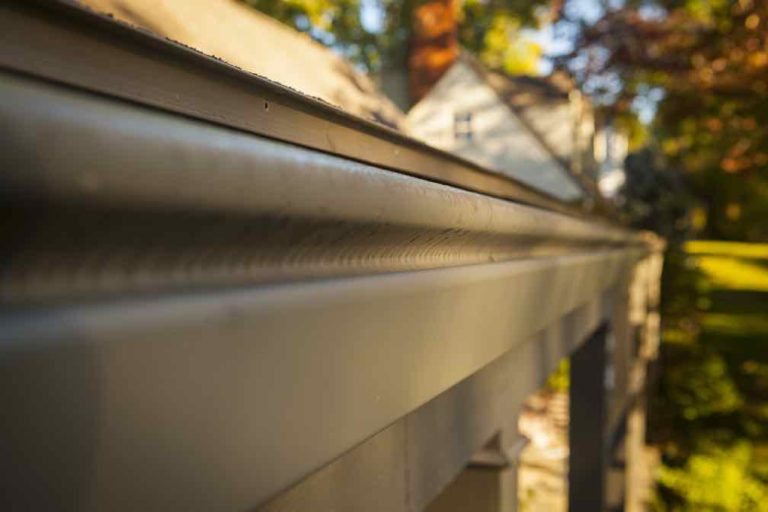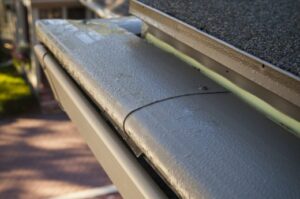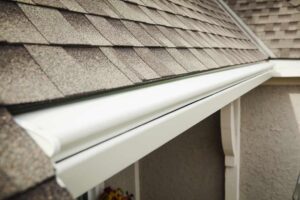Every home needs a gutter system to protect it from water. If homes didn’t have gutter systems, meltwater and stormwater would be left to sit and collect around a home’s foundation, creating a ton of costly damage. There are plenty of dangers of not having gutters on your home.
Fortunately, most homes do have a gutter system installed. Older homes usually have one while some newer construction homes do not. Whether you’re the homeowner of an older home that needs new gutters or if you recently purchased a newer construction home that needs them installed, there are numerous gutter systems to choose from.
From aluminum to vinyl, there are plenty of gutter material options available on the market. How do you choose which one is right for your home? First, you’ll need to understand how well different materials hold up in the climate you live in. The Heartland has all four seasons and sees all sorts of weather patterns year-round. We experience stormy weather throughout the year and it’s important to choose a gutter material that can withstand our climate.
Keep reading as we explain the differences between the 4 most common gutter materials so you can be prepared to make a decision that complements your home’s beauty and saves you money in the long run.
1. Aluminum
Aluminum is one of the most popular gutter materials and has a couple of advantages when compared to others. First, they’re often low cost, and second, they resist rust as opposed to other metals.
The aluminum used in traditional, open-top gutter systems will show wear and tear easily from weather events that produce hail, heavy rain, and snow. As we previously mentioned, we often experience fluctuating temperatures with heavy amounts of rain and snow here in The Heartland and these weather patterns will wreak havoc on your traditional aluminum gutter system. Storms that produce hail and heavy snow will leave dents and can cause a traditional gutter system to pull away from the home resulting in sagging gutters.
Unlike traditional open-top aluminum gutters, the K-Guard Leaf Free Gutter System is made of heavy-duty aluminum and the base material will never corrode and the paint will never chip. This is because K-Guard uses a .032 gauge aluminum, which is the thickest aluminum coil you can order, to make sure that it will last the lifetime of your home. Our seamless gutter system can also withstand all types of weather conditions and won’t pull away from your home in the event of severe weather.
2. Copper
While copper does have its advantages and disadvantages, it may be the best option for vintage homes. Copper has been used for gutter systems for a very long time, dating back to the 1800s. While they are eye-catching, copper gutters require regular maintenance to keep them looking their best.
Whenever copper is exposed to the elements like heat, rain, and snow, the metal will transform due to oxidization. Copper gutters are beautiful once they’re first installed but over time will fade from that shiny gold color into a more bluish hue, giving a tarnished look. They also cost roughly five times more than other gutter materials on the market.
3. Steel
Steel gutters come in two finishes: stainless and galvanized. Because steel is one of the strongest materials, a gutter system that’s constructed of steel can be very durable. Although steel is strong and can hold up well in severe weather, it will rust over time if it’s not constructed of stainless steel. If a gutter system is galvanized then the protective layer that’s applied to them will rust and warp with time.
In addition to galvanized steel gutters being prone to rust over time, they can sag if that protective layer isn’t applied. Stainless steel gutters can be about four times more expensive than other gutter materials on the market, so use caution when considering them.
4. Vinyl
Vinyl gutters are a popular choice among homeowners because of their affordability and how easy they are to install. However, they are not a wise choice for homes in The Heartland due to our heavier amounts of precipitation and fluctuating temperatures year-round. Why? Vinyl gutters are lightweight and shouldn’t be exposed to heavy rain, snow, and high winds. While vinyl gutters can save you money initially, they will end up costing you more in the long run when compared to other gutter materials.
Aluminum, copper, steel, and vinyl gutters are the 4 most common materials that homeowners compare when shopping for a new gutter system. While these materials can result in a durable gutter system, nothing can beat the durability and lifespan of K-Guard Gutter Guards.
Living in The Greater Kansas City Area exposes our gutter systems to high heat and freezing temperatures, heavy rainfall and snow, and high winds, so your gutter system needs to hold up to these extreme elements. The K-Guard Gutter System can withstand all types of weather conditions and is even guaranteed to be transferable for the life of the home. Traditional open-top gutter systems have a much shorter lifespan.
If you’re interested in learning more about the K-Guard Gutter System or if you have any questions, contact us today. We offer free in-home estimates that include a detailed analysis of your current gutter system along with estimated costs for installing your K-Guard Gutter System. K-Guard proudly offers our gutter installation service to homeowners across both Missouri and Kansas including, but not limited to, the following locations:




